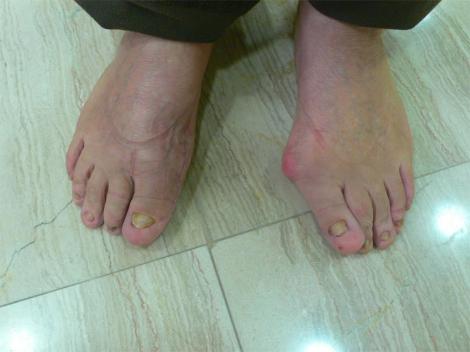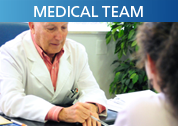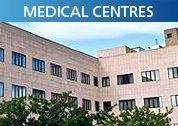


Specialized Centers
HOSPITAL CLÍNICA BENIDORM (HCB)
HOSPITAL CLÍNICO VISTAHERMOSA
HOSPITAL INTERNACIONAL MEDIMAR
Hallux Valgus (bunion deformity) and Metatarsalgia (metatarsal pain)
These are among the most common foot problems and affect women more than they do men. A bunion is a painful bony prominence (bump) on the joint where the big toe meets the main bones of the foot. The condition causes the end of the big toe to bend towards the other toes, crowding and deforming them (hammer toes), interfering with normal motion, which in turn causes matatarsalgia (pain in the ball of the foot) and calluses.
Benefits of the operation
This surgery treats one of the most common conditions affecting the foot, especially in women. Bunion surgery corrects the anatomy of the front of the foot, allowing the patient to walk normally and relieving foot pain and giving it a normal appearance again.
Nowadays it is fair to say that bunion surgery has lost its reputation as a "very painful operation" because it is very well tolerated by patients.
Medical-technical description
The treatment consists of surgical correction of the deformity. Modern open surgery or minimally invasive (MIS) surgical techniques are used as required. In any case, a series of cuts (osteotomies) are made in the bone to correct the deformities. Sometimes screws or staples are used to fix the bones in place. The disadvantage of open surgery is that scars are larger, however, the deformity can be corrected more accurately and there is less risk of any recurrence. This method is more effective in the case of major deformities. MIS surgery has the advantage that the incisions are smaller and the disadvantage that it is not suitable in all cases.
Your specialist surgeon will give you individual advice about the best solution to your problem.
About the operation
Foot surgery always takes place in the operating theatre, and generally requires a tourniquet or blood pressure cuff to be applied to the thigh. Spinal or regional anaesthesia at knee level is generally used in these cases, for a more comfortable post-operative period and far less pain than experienced with conventional knee surgery.
This procedure can take between 30 and 60 minutes, according to the condition to treat. Patients generally spend a few hours in hospital and are able to go home that evening; however you may need to spend a night in hospital, depending on your individual case. On release, you will be given a release report setting out the recommendations, treatment to follow and subsequent appointments.
Before the operation
- The patient goes to the doctor's office for a prior consultation, decisions are taken and the doctor explains the surgery in detail and gives the patient an informed consent.
- You must take a list of all the medications you use (including medicinal plants) to the hospital with you on the day of your surgery.
- You will have pre-surgical tests consisting of a full blood test, biochemistry, coagulation, chest x-ray and ECG.
- You must wash the surgical site with antiseptic soap on the night before and on the morning of the surgery.
- For four weeks after the operation you will need to wear special shoes to enable you to walk. These shoes can have inverted or French heels or they can be flat. Your doctor will tell you what type of shoes to wear.
- If you are to have your surgery in the morning, you must not eat or drink anything that morning. If the surgery is to take place in the afternoon, have an early breakfast then do not eat or drink anything after 9 am.
- You must remove all metal objects during the operation (rings, bracelets, earrings, body piercings, etc).
Post-operative care
- For the first days after the surgery you may suffer some discomfort or swelling, which will disappear when you take the medicine prescribed by the surgeon.
- A compression bandage will be applied which you must wear until you go to have the wound dressed for the first time.
- Correct rehabilitation is necessary, so on the first few days you must not travel or do any strenuous or violent movements.
- You will be able to stand and walk immediately after the operation, but you must always wear the shoes you have been told to.
- You will receive anti-clotting and antibiotic treatment while you are in hospital.
- After release, you should contact us if you suffer from chest pain or have breathing difficulties, swelling or reddening in a leg, sharp pain in the foot on which you have had the surgery, fever or shivering.
The importance of immediate rehabilitation
- Correct rehabilitation is essential after an operation of this type. Rehabilitation should start as soon as possible and on the first few days you must not travel or do any strenuous or violent movements. That is why we recommend that before you go back to your country you should spend at least eight days doing rehabilitation at our Casaverde rehabilitation centre.
- This will help you to improve muscle tone and for the muscles affected by the surgery to gradually become stronger, which will reduce the risk of falling or complications.
- This will optimise mobility of the joint affected and reduce any pain and/or discomfort that may appear after the surgery.
- Improves trophism – nourishes the tissues around the operation site and encourages correct healing and closure of the surgical wound.
- Restores motor skills, giving patients help, guidance and re-educating them adopt walking patterns that will soon have them on the road to recovery.



